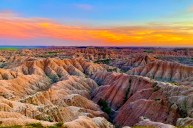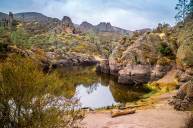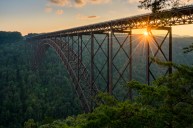Five new national parks have been added in the last 10 years. Out of the 400 national park sites in the nation, only 63 of those hold the prestigious title as a designated National Park. The five newest of those—New River Gorge National Park, White Sands National Park, Indiana Dunes National Park, Gateway Arch National Park, and Pinnacles National Park—are all unique destinations in their own right.
And for park aficionado, it's exciting to have new sites to add to your bucket list.
Whether it's pebbled shorelines, sparkly sandy vistas, or craggy mountaintops, there is plenty to see within these five newest parks.
1. New River Gorge National Park — West Virginia

Tim Pennington/Getty
The newest national park in the whole system is New River Gorge National Park in West Virginia, which was established in 2020. It's an adrenaline junkie's playground, with 1,500 rock climbing routes up limestone cliffs and 53 miles of whitewater rafting (including a wild 13-mile stretch of Class IV and V rapids), plus thrilling mountain bike trails.
Other fun things to do at New River Gorge include ziplining over the 1,000-foot gorge, exploring the historical Kaymoor Miner's Trail, or taking a leisurely cruise through the park's scenic routes.
The park gets around 1.2 million visitors a year.
2. White Sands — New Mexico

mcveras/Getty
For the first 86 years of its recognition, White Sands was a National Monument. But in 2019 it received its full designation of National Park. The landscape is marvelous, where wave-like dunes of gypsum sand engulf 275 square miles of desert. Home to coyotes, bobcats, raptors, and the highly poisonous Maricopa harvester ant, the gypsum dunefield at White Sands is the largest on the planet.
Gypsum sand is cool to the touch, even in the heat and also extremely rare, because of its high dissolution when it meets water. Even more interesting is that water can be found only a foot underneath the dunes. White Sands welcomes around 600,000 visitors a year, who enjoy a variety of activities including backcountry camping, horseback riding, surfing the dunes, and more.
3. Indiana Dunes — Indiana

PhotosbyLarissaB/Getty
This lakefront park, which was officially designated in 2019, stretches for about 20 miles where the power and persistence of Lake Michigan has shaped the coastline into a rich mosaic of habitats.
The park contains about 50 miles of trails lead through shifting sand dunes, quiet woodlands, sunny prairies and lush wetlands. Park visitors can partake in hiking, snowshoeing, running, or camping at the well-equipped Dunewood Campground. Indiana Dunes National Park, which receives about 2.2 million visitors a year, is full of wildlife, including whitetail deer, Canada geese, hawks, and red fox.
4. Gateway Arch — Missouri

Pgiam/Getty
Gateway Arch National Park, established in 2018, looks a little different than many park sites in the national park system in that it is located smack-dab in the middle of the city. It is not alone, however; Fort Stanwix National Monument is also located in the center of a city, in this case Rome, New York. The park is a memorial to Thomas Jefferson's role in opening the West, to the pioneers who helped shape its history, and to Dred Scott who sued for his freedom in the Old Courthouse. Gateway Arch is most famous for the huge arch that was built in 1965.
There are no camping or hiking opportunities for the two million visitors per year at Gateway Arch, but they can take a tram ride to the arch's top or enjoy a riverboat cruise.
Fun fact: Welded into the keystone at the top of the 630-foot arch is a time capsule containing 762,000 signatures of the city's students and well-wishers that will never be opened. Some conspiracy theorists believe the arch is a meeting place for extra-terrestrials and it can control the weather.
5. Pinnacles — California

zrfphoto/Getty
One of the quieter parks in the National Park Service network is Pinnacles National Park. It offers a welcome reprieve from the crowds of Yosemite but still serves up some stunning views.
The park's annual 250,000 visitors enjoy meandering through chaparral, oak woodlands, and canyon bottoms. Adventurous hikers enter rare talus caves and emerge to towering rock spires teeming with life, including the California condor, golden eagles, wild turkeys, cougar, and a variety of falcon.
The San Andreas Fault is visible from some trails and there is also an extinct volcano in the park. Pinnacles has some challenging terrain; a hike called the "Pig Fence" is a strenuous part of South Wilderness Trail that in some parts is so steep, it requires hanging on to the fence put up to keep feral pigs out of the park. Birdwatchers can enjoy an easy trek to an overlook on Condor Gulch Trail.




